![]()
![]()
![]()
Use LEFT and RIGHT arrow keys to navigate between flashcards;
Use UP and DOWN arrow keys to flip the card;
H to show hint;
A reads text to speech;
31 Cards in this Set
- Front
- Back
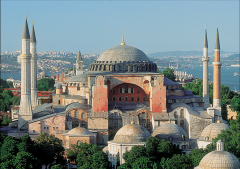
|
Name: Church of Hagia Sophia (8-2) Date: 532-537 Location: Constantinople, Modern Istanbul Civilization: Early Byzantine Makers: Anthemius and Isidorus Significance: Largest free standing dome from ancient times. Made under the reign of Justinian I and Theodora. It is a central plan church built in only 5 years/ means "Holy Wisdom" |
|
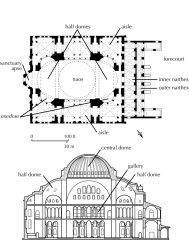
|
Plan of hagia sophia half domes- conches |
|
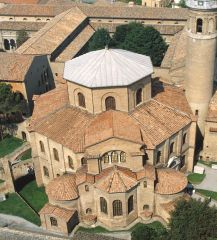
|
Name: Church of San Vitale (8-5) Date: 520-547 Consecrated in 547 Location: Ravenna, Italy Civilization: Early Byzantine Significance: It is a martyrium; built over the grave of St. Vitalis. Bishop Ecclesius commissioned its building. Finished after Justinian conquered Ravenna. Central plan church. Martyium; built over grave of martyr St. Vitalis. |
|
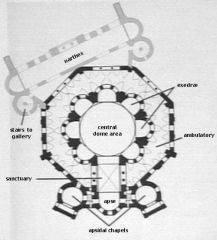
|
Plan of church of san vitale |
|

|
Christ Enthroned located in apse of church of San Vitale Flanked by angels and St. Vitalis and bishop Ecclesius. |
|
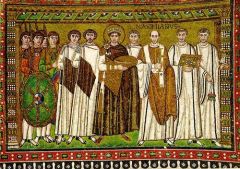
|
Emperor Justinian and His Attendants North Wall of the Apse in Church of San Vitale Bishop Maximianus is at his left |
|
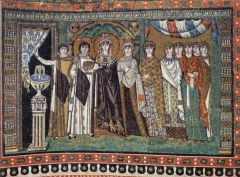
|
Empress Theodora and Her Attendants South Wall of the Apse in Church of San Vitale
|
|

|
Name: The Archangel Michael Diptych (8-12) Date: Early 6th Century Location: Court Workshop at Constantinople Civilization: Early Byzantine Material: Ivory Very Roman- standing under arch/ staff in one hand globe in the other- related to Roman emperor/ commemorative ivory diptychs are two carved panels hinged together. This is half of a diptych |
|
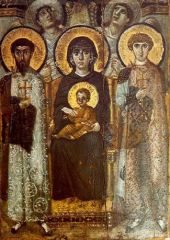
|
Name: Virgin and Child with Saints and Angels (8-14) Date: Second half of 6th century Location: Monastery of St. Catherine, Mount Sinai, Egypt Civilization: Early Byzantine Material: Encaustic on Wood It is an icon used in worship. flanked by the warrior saints Theodore (left) and George (right). Iconoclastic period was a when icons were outlawed and destroyed/ all have halos around their heads |
|
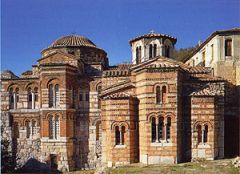
|
Name: Monastery Churches at Hosios Loukas (8-17) Date: Katholikon main church (left) Early 11th century and church of the Theotokos (right) late 10th century Location: Central Greece/ few miles from the villae of Stiris Civilization: Middle Byzantine Katholikon is the main church and is a central plan.
|
|
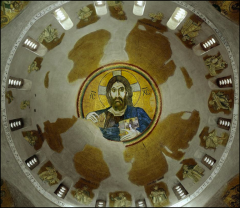
|
Name: Christ Pantokrater with Scenes From the Life of Christ (8-21) Date: 1100 Location: Church of the Dormition, Daphni, Greece Civilization: Middle Byzantine Style: Mosaic On the dome roof of the church of the Dormition. The four corners show episodes from his life. |
|
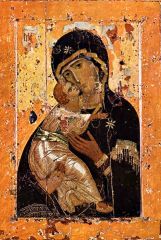
|
Name: Virgin of Vladamir (8-28) Date: 12th century Location: probably painted in Constantinople. Moved to Kiev and eventually to Vladimir. Civilization: Middle Byzantine Material: Tempera on panel Was an icon created after iconoclasm. |
|
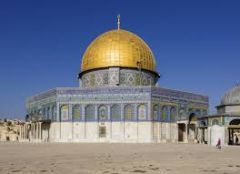
|
Name: The Dome of the Rock (9-3) Date: begun 691 Location: Jerusalem, Israel, built on a rocky outcrop called the Harim al-Sharif (Noble Sanctuary) Civilization: Early Islamic/ The Early Period Believed by Muslims to be the place Muhammed accented into heaven/ Also holy for Christians and Jews/ Solomon/ Creation of Adam/ Abraham to sacrifice Isaac |
|
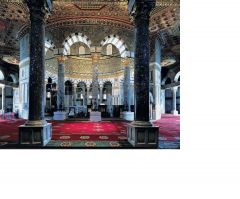
|
Name: Interior of the dome of the rock (9-4) Arches are encrusted with golden mosaics. |
|
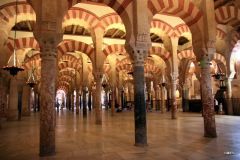
|
Name: Prayer Hall (9-6) Date: 785 Location: The Great Mosque of Corboda, Spain Civilization: Early Islmamic/ Umayyad Dynasty Ruler: Abd al-Rahman Columns are made of marble. The arches are alternating white stone and red-brick style adopted from Byzantines and Romans. The ruler or emir Abd al-Rahman fled to Spain and made a capital of the Umayyads at Corboda
|
|

|
Name: Dome in Front of the Mihrab (9-8) Date: 965 Location: The Great Mosque of Cordoba, Spain Civilization: Early Islamic/ Umayyad Dynasty Ruler: Al-Hakam II commissioned its building The ceiling was installed with ceramic and glass tiles by a Byzantine master. |
|
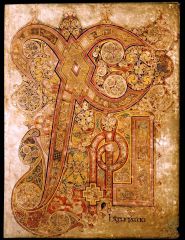
|
Name: Chi Rho Iota Page from the Book of Kells (15-1) Date: Late 8th early 9th century Location: Iona, Scotland/ maybe Ireland Civilization: Early Medieval Material: Oxgall inks and pigments on vellum Significance: Signals Christ's first appearance within the gospel of Matthew. Purpose: Would evoke Christ's presence on the altar where it was housed. The book of Kells is an illustrative book of the Gospel/ Was probably brought to Kells by monks after the island of Iona was raided by vikings/ Chi Rho Iota abbreviates the phrase Christi from Matthew 1:18
|
|

|
Name: Matthew Writing His Gospel, Lindisfarne Gospel Book (15-7) Date: 715-720 Location: Lindisfarne/ British Isles Civilization: Early Medieval Material: Ink and tempera on vellum Creator: Written by Eadfrith bound by Ethelwald The Lindisfarne Gospel Book was primarily used for carrying in processions and to be displayed on the altar. A priest named Aldred added a section describing the books history. Early Chrisitian Art of the British Isles. Required 300 calf skins to make the vellum it is composed of |
|

|
Name: South Cross, Ahenny (15-9) Date: 8th Century Location: County Tipperary, Ireland Civilization: Early Medieval Material: Sandstone design of monumental stone crosses was influenced by metalworking traditions. Early Christian Art of the British Isles
|
|
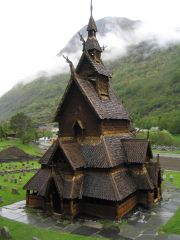
|
Name: Borgund Stave Church (15-14) Date: 1125-1150 Location: Borgund Norway Civilization: The Viking Era/ Early Medieval Material: Timber The Vikings became Orthodox Christians/ named after the four huge timber staves that from the structure |
|
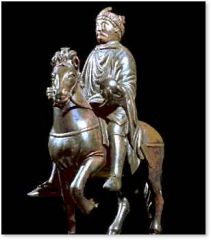
|
Name: Equestrian Portrait of Charles the Bald (15-15) Date: 9th Century Civilization: Carolingian/ Early Medieval Material: Bronze Purpose: Represents the Carolingian rulers' ascent to the Roman imperium. Charles the Bald was Charlemagne's grandson. The mustache he has is a Frankish sign of nobility |
|
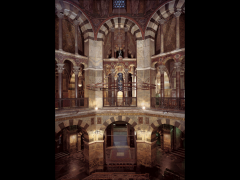
|
Name: Palace Chapel of Charlemagne (15-16) Date: 792-805 Location: Aachen, Germany Civilization: Carolingian/ Early Medieval this chapel was located in Charlemagne's palace complex/ The chapel was a central plan church/ They added a western entrance block called a westwork that had an upper story throne room for the emperor to view the liturgy |
|
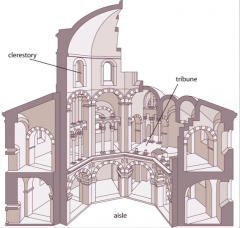
|
Plan of palace chapel of charlemagne |
|

|
Name: Westwork Abbey Church of Corvey (15-17) Date: Late 9th Century/ upper stories mid 12th Location: Westphalia, Germany Civilization: Carolingian/ Early Medieval Purpose: Carolingian Westworks functioned symbolically as a sign of an important building. Originally designed for practical protection and display. |
|
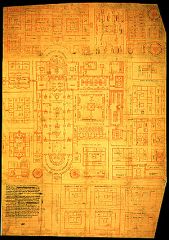
|
Name: Saint Gall Plan (5-18) Date: 817 Location: Saint Gall, Switzerland Civilization: Carolingian/ Early Medieval Material: Original in red ink on parchement Creator: Abbot Haito of Reichenau was asked by abbot Gozbert of Saint Gall to make it Reflects the basic design used in the layout of medieval monasteries/ still used today for Benedictine Monastaries |
|
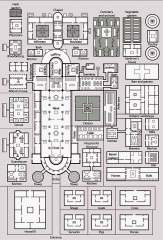
|
Saint Gall Plan |
|
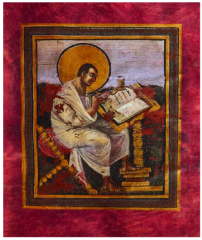
|
Name: Page with St. Matthew the Evangelist, Coronation Gospels (15-19) Date: Early 9th Century Civilization: Carolingian/ Early Medieval Purpose: It was used in coronation ceremonies Significance: Possible buried with Charlemagne and later removed from his tomb by Otto III. Style may have been learned from Byzantium manuscripts or from artists fleeing Byzantium as a result of the iconoclastic controversy.
|
|
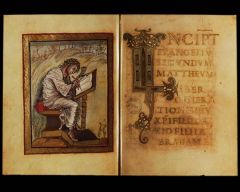
|
Name: Page with St. Matthew The Evangelist, Ebbo Gospels (15-20) Date: second quarter of 9th century Civilization: Carolingian Material: Ink, gold, and colors on vellum Location: Abbey of Hautvillers Purpose: Made for Archbishop Ebbo of Reims Calligraphic painting/ manuscript painting
|
|

|
Name: The Convent Church of St. Cyriakus, Gernrode (15-23) Date: Begun 961 Location: Harz, Saxony-Anhalt, Germany Civilization: Ottonian Empire/ Early Medieval Founded by Gero/ Gero appointed his daughter-in-law to be the convent's first abbess
|
|

|
Name: Gero Crucifix (15-24) Date: 970 Location: Cologne Cathedral, Germany Civilization: Ottonian Empire/ Early Medieval Material: Painted and gilded wood/ oak Purpose: To be a crucifix suspended over an altar and a special kind of reliquary. A cavity on the back of the head was made to hold a piece of communion bread. Archbishop Gero of Cologne comissioned the sculpture for his cathedral/ the Ottonian chronicle of Thietmar of Meresburg said Gero placed a fragment of the true cross into a crack that formed.
|
|
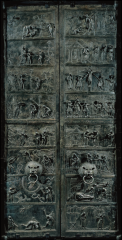
|
Name: Doors of Bishop Bernward/ The Hildesheim Doors (15-25) Date: 1015 Location: Church of St. Michael, Hildesheim, Germany Material: Bronze Civilization: Ottonian Empire/ Early Medieval Made by Bernward a skilled goldsmith/ Displays story of Adam and Eve on left and Jesus's life on right
|

